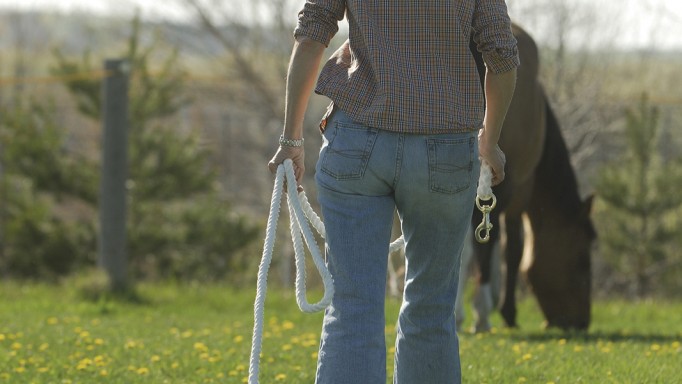You probably turn your horses out in a paddock or field every day – and then catch them up again when it’s time for supper – without really giving it much thought. But there is a right way and many wrong ways to accomplish this simple task, especially if you’re dealing with young or fractious horses.
First, having proper equipment is important. Halters should be lightweight leather and easy to get off; leads should have snaps that come undone easily. “We will leave leather halters on young stock in the field, especially if they don’t like to be caught up,” explains Arnoldt. Gloves are a good idea for handlers, as well.
Training to release at the gate in a civil manner – like all ground handling tasks covered in this series -should start when foals are young. “Lead the little guys from the start with the mare, so they get into the routine,” says Arnoldt. “Lead the foal into the field first, followed by the mare; let the foal go, then let the mare go. The foal doesn’t want to leave his mom, so he will stick around until you release her.”
Body position during the release is crucial from a safety standpoint. “I’m a big stickler for this – get the horse completely through the gate, turn his head toward you and let him go. Once they’re turned toward you – even if they’re rambunctious and eager to buck around – it takes them longer to turn and kick out at you, which gives you time to step out of their way.”
Arnoldt describes a scene he has witnessed too often: “Never just let them go as you walk into the field. Even horses you know well can wheel and kick .They’re not trying to kick you, they’re just happy to be out and you’re in the wrong place at the wrong time. The horse likely didn’t even realize that you were in the ‘splash zone.”
If you have a horse that is anxious to be released, or bolts before you can get him unsnapped, Arnoldt suggests using a second halter or a second lead rope. With two halters, you can ease off the first halter, but the lead remains snapped to the second halter so that you can remind the horse that he’s still under your control. The same is true if using two leads; unsnap the first one while still controlling with the second.
Arnoldt adds that you can try distracting them with a handful of grain while you quietly unsnap the rope or remove the halter. Chances are the presence of the snack will encourage them to stick around for a minute.”You can’t blame them for wanting to run off – it’s their play time,” he says, “but it shouldn’t be like you’re releasing them into the wild each time!”
Catching up is not usually a problem, as most horses come to realize there is a reward if they comply – dinner, respite from the flies, etc. And there is always a pecking order if you have a big gang waiting at the gate. “It’s usually pretty obvious who should come out first,” says Arnoldt. “There’s always the eager beaver waiting at the gate. If you try to take another horse out first, they might get bullyish and chase them off (or injure you). Even the one that doesn’t want to be caught will be eager to come in once you’ve taken all his buddies out of the field.”
If you have to enter the field to approach the horse you want to catch, make sure you do not come up directly behind him, but preferably from the front at a slight diagonal angle so he can see you. Walk with purpose, speak quietly, never yell or wave your arms. While Arnoldt at Dreamscape Farms is not a big proponent of food rewards, if the horse is evasive and “bringing along a little treat saves you half an hour trying to catch him up, that’s not a bad thing – once in a while.”
“In a sand paddock, you don’t normally have that problem,” he says. “But we have mares and foals in a big grass pasture and need to bring them in for ultrasounds and so on once in a while. To get those mares, sometimes you do need a bucket of grain, because they’re happy and could care less what you want!”
Over time, patience and consistency will win out. “They will eventually learn that when you approach with a halter and lead, it’s time to come in.”

